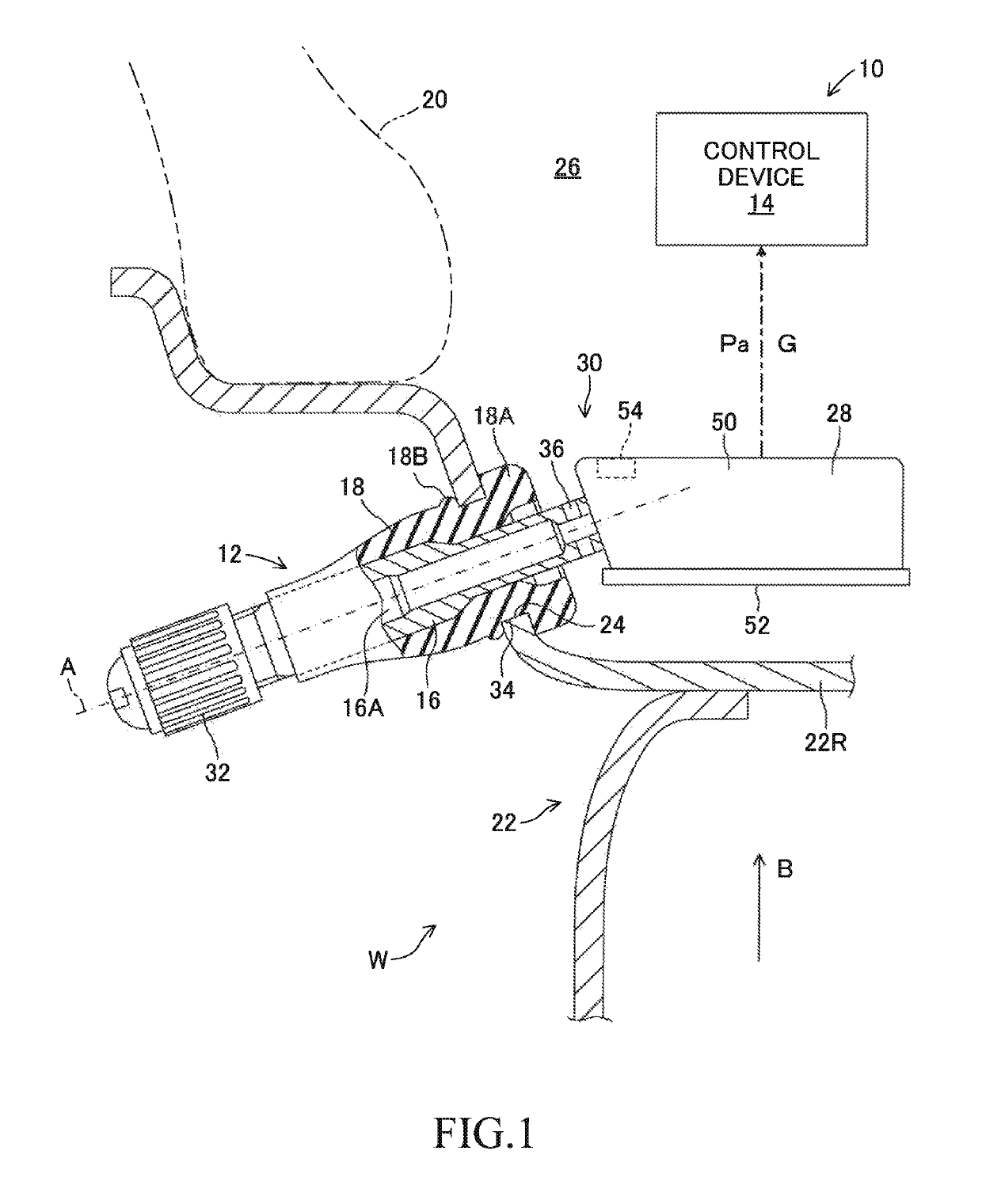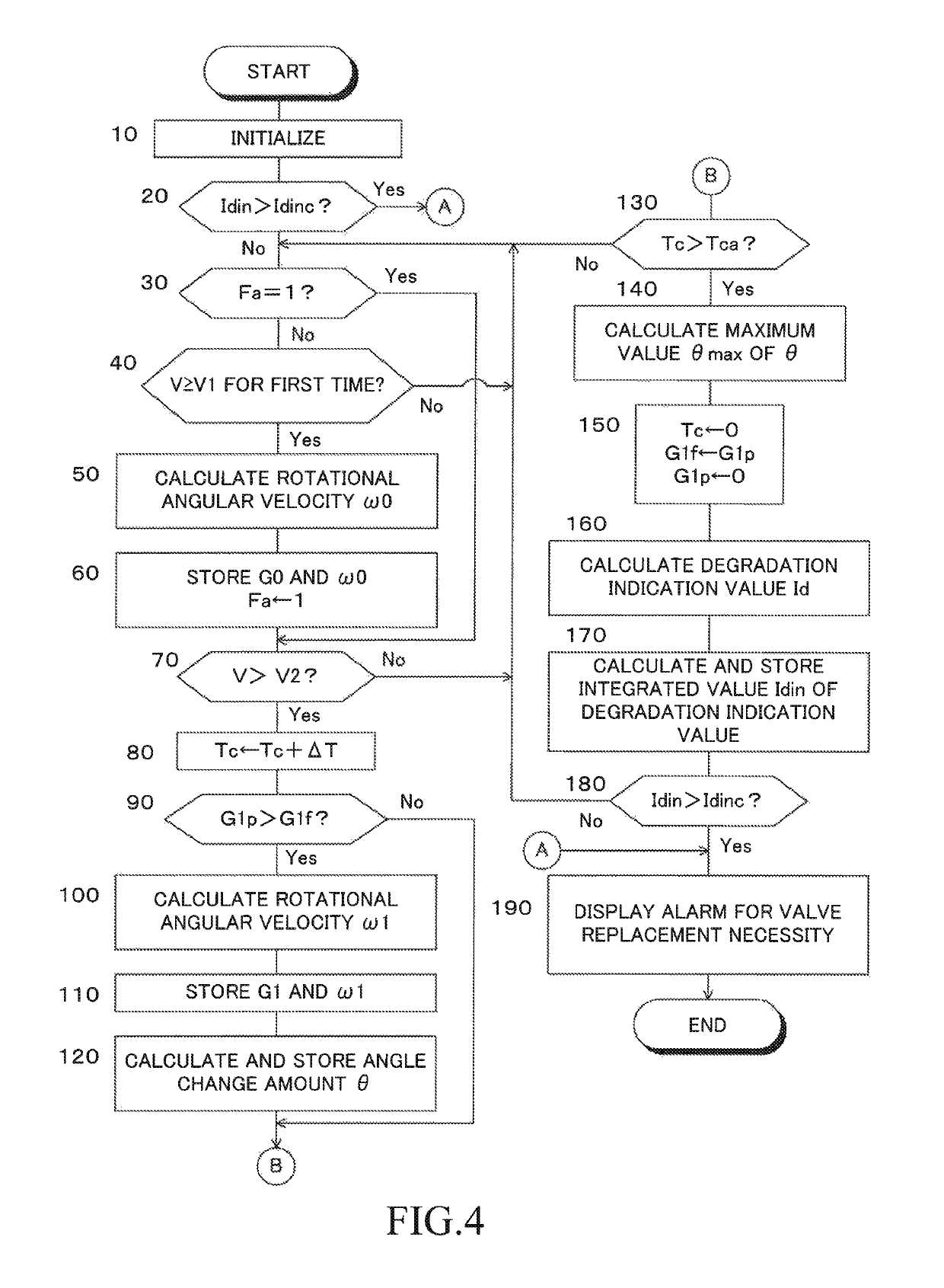Replacement necessity determination device for snap-in valve
a technology of necessity determination and snap-in valve, which is applied in the direction of fluid tightness measurement, instruments, vehicle sub-unit features, etc., can solve the problems of secular degradation, acceleration sensor cannot appropriately detect the acceleration of the wheel assembly in the radial direction, and the tire air pressure quickly decreases
- Summary
- Abstract
- Description
- Claims
- Application Information
AI Technical Summary
Benefits of technology
Problems solved by technology
Method used
Image
Examples
first embodiment
[0045][First Embodiment]
[0046]A replacement necessity determination device 10 illustrated in FIG. 1, which is a schematic configuration diagram, and FIG. 2, which is a block diagram, includes a control device 14 for determining replacement necessity for a snap-in valve 12. The snap-in valve 12 includes a valve stem 16 having a tubular shape extending along an axis A, and an elastic body 18 covering an entire periphery of a region except for both ends of the valve stem 16. The valve stem 16 is formed of metal. The elastic body 18 is formed of rubber. The valve stem 16 may be formed of rigid plastic, and the elastic body 18 may be formed of resin. In each wheel assembly W of a vehicle (not shown), one snap-in valve 12 is installed on a metal wheel 22 for retaining a tire 20 on an outer periphery thereof, but the control device 14 is installed in a vehicle body of the vehicle as one control device common to the plurality of snap-in valves 12.
[0047]As illustrated in FIG. 1, the snap-in ...
second embodiment
[0112][Second Embodiment]
[0113]FIG. 5 is a block diagram of the replacement necessity determination device 10 according to a second embodiment of the present disclosure. In FIG. 5, the same components as the components illustrated in FIG. 2 are denoted by the same reference symbols as those assigned in FIG. 2.
[0114]According to the second embodiment, wheel assembly speeds Vwi [rpm] (i=fl, fr, rl, and rr) of the front left, front right, rear left, and rear right wheel assemblies (not shown) are detected by wheel assembly speed sensors 72i (i=fl, fr, rl, and rr). Signals representing the wheel assembly speeds Vwi are input to the electronic control device 60 from the wheel assembly speed sensors 72i.
[0115]Further, according to the second embodiment, the determination control for the necessity of the replacement of the snap-in valve 12 is carried out in accordance with a flowchart illustrated in FIG. 6. In FIG. 6, the same step as the step illustrated in FIG. 4 is denoted by the same ...
third embodiment
[0123][Third Embodiment]
[0124]FIG. 7 is a flowchart for illustrating a principal part of a determination control routine for replacement necessity for the snap-in valve 12 in the replacement necessity determination device 10 according to a third embodiment of the present disclosure constructed as a modified example of the first and second embodiments.
[0125]According to the third embodiment, Step 10 to Step 170 are carried out in the same manner as in the cases of the first and second embodiments, but Step 175 is carried out in place of Step 180 when Step 170 is completed.
[0126]In Step 175, it is determined whether or not the integrated value Idin of the degradation indication value Id is more than a first reference value Idinc1 set in advance, that is, it is determined whether or not the timing of the replacement of the snap-in valve 12 is approaching. When a negative determination is made, the control returns to Step 30, and when an affirmative determination is made, the control pr...
PUM
 Login to View More
Login to View More Abstract
Description
Claims
Application Information
 Login to View More
Login to View More - R&D
- Intellectual Property
- Life Sciences
- Materials
- Tech Scout
- Unparalleled Data Quality
- Higher Quality Content
- 60% Fewer Hallucinations
Browse by: Latest US Patents, China's latest patents, Technical Efficacy Thesaurus, Application Domain, Technology Topic, Popular Technical Reports.
© 2025 PatSnap. All rights reserved.Legal|Privacy policy|Modern Slavery Act Transparency Statement|Sitemap|About US| Contact US: help@patsnap.com



